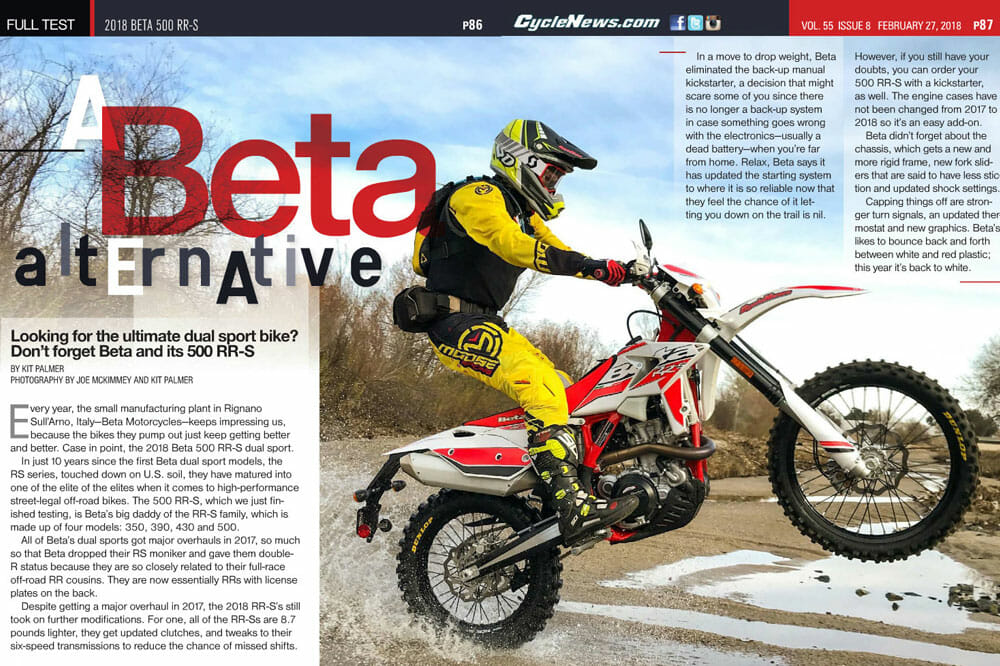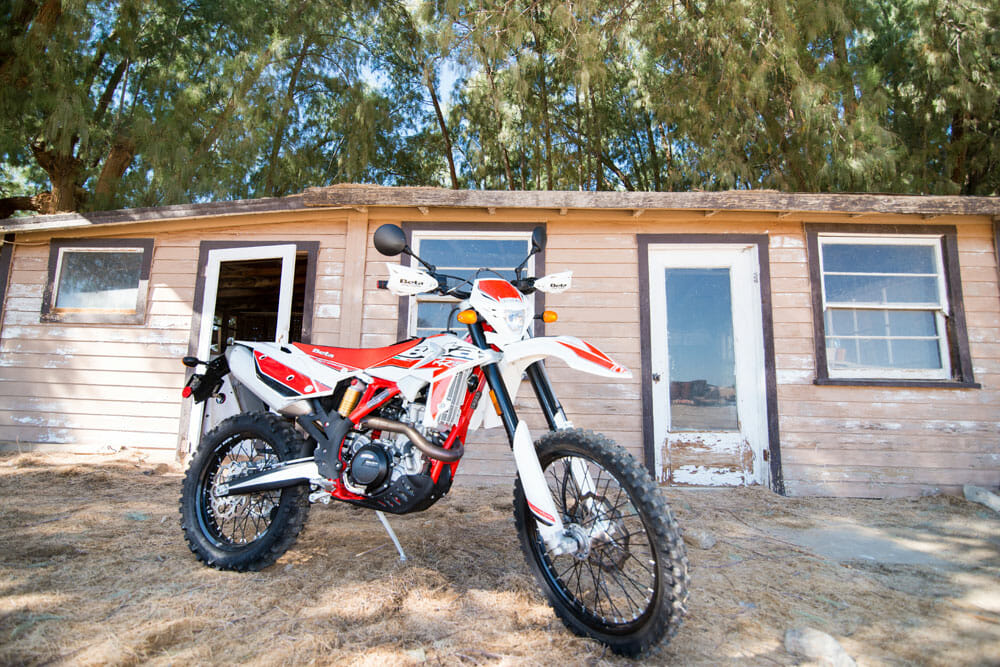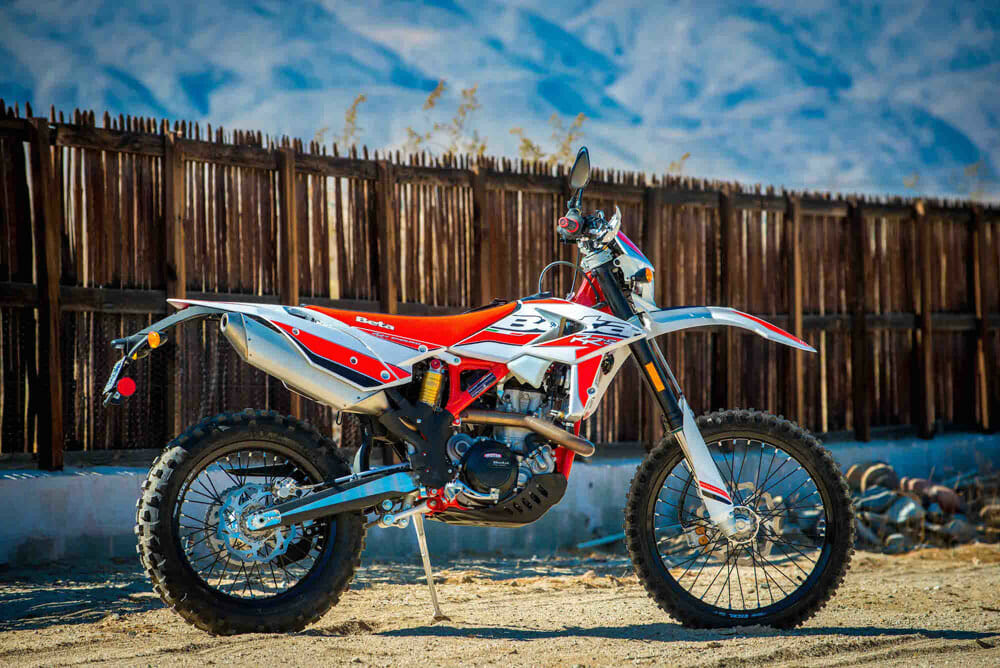Kit Palmer | March 3, 2018
2018 Beta 500 RR-S | FULL TEST | A Beta Alternative – Looking for the ultimate dual sport bike? Don’t forget Beta and its 500 RR-S.
Every year, the small manufacturing plant in Rignano Sull’Arno, Italy—Beta Motorcycles—keeps impressing us, because the bikes they pump out just keep getting better and better. Case in point, the 2018 Beta 500 RR-S dual sport.

In just 10 years since the first Beta dual sport models, the RS series, touched down on U.S. soil, they have matured into one of the elite of the elites when it comes to high-performance street-legal off-road bikes. The 500 RR-S, which we just finished testing, is Beta’s big daddy of the RR-S family, which is made up of four models: 350, 390, 430 and 500.
All of Beta’s dual sports got major overhauls in 2017, so much so that Beta dropped their RS moniker and gave them double-R status because they are so closely related to their full-race off-road RR cousins. They are now essentially RRs with license plates on the back.

PHOTOGRAPHY BY JOE MCKIMMEY AND KIT PALMER
Despite getting a major overhaul in 2017, the 2018 RR-S’s still took on further modifications. For one, all of the RR-Ss are 8.7 pounds lighter, they get updated clutches, and tweaks to their six-speed transmissions to reduce the chance of missed shifts.
In a move to drop weight, Beta eliminated the back-up manual kickstarter, a decision that might scare some of you since there is no longer a back-up system in case something goes wrong with the electronics—usually a dead battery—when you’re far from home. Relax, Beta says it has updated the starting system to where it is so reliable now that they feel the chance of it letting you down on the trail is nil. However, if you still have your doubts, you can order your 500 RR-S with a kickstarter, as well. The engine cases have not been changed from 2017 to 2018 so it’s an easy add-on.
Beta didn’t forget about the chassis, which gets a new and more rigid frame, new fork sliders that are said to have less stiction and updated shock settings.
Capping things off are stronger turn signals, an updated thermostat and new graphics. Beta’s likes to bounce back and forth between white and red plastic; this year it’s back to white.
And what hasn’t changed? How about this? The price. It carries over its 2017 $9999 asking price.
 The new Beta 500 RR-S is pretty.
The new Beta 500 RR-S is pretty.
Go Anywhere, Do Anything
We’ll get straight to the point, the Beta 500 RR-S is an outstanding dual sport bike, as long as your definition of dual sporting is 99% hardcore off-road riding; okay, it doesn’t necessarily have to be hardcore, but as long as you want to make dust or throw a big roost, the Beta does the trick.
You can feel its Beta off-road bloodline instantly. The RR-S is definitely a dirt bike at heart. It’s not often that I load up a dual sport bike to go riding; instead, most of my dual sport rides are initiated right from my driveway, quickly followed by some pavement, as was my first outing on the Beta. A few shifts into it, the 500 RR-S confirmed what I already knew—this bike is not a street bike. Not by any means. But, hey, it did get me to where I wanted to go, legally, but not soon enough; its stiff seat and firm ride had me longing for the dirt, my initial destination. And relief came as soon as the Beta’s knobbies touched it. Ahh, now we’re talkin’.
 The 500 RR-S makes a lot of power but it’s all useable.
The 500 RR-S makes a lot of power but it’s all useable.
This is where the Beta is happy—on the dirt. And it’s very capable on it. There isn’t much the 500 RR-S can’t do when it’s in its element like this—its limitations are pretty much dictated by the rider’s own limitations. For a big bike, the Beta is quite agile and responsive on the trail; don’t let its 500cc displacement make you think otherwise. It’s by no means a beast. It’s easy to ride. The Beta’s actual 478cc, four-valve, four-stroke, engine makes a ton power, but it’s all useable power. You can plonk around on it or let it rip—either way is fine. And don’t think for a second that this bike isn’t fast; it is, but not scary fast.
The Beta rolls off the showroom floor geared fairly tall, its 15/48-tooth sprocket combo keeps you from getting run over by cars on the open highway. Luckily, the Beta has enough torque and bottom-end that it will still pull you out of just about any sticky slow-speed, low-rpm situation on the trail but usually not without some fancy clutch work. You’ll find yourself running around in first gear a lot more on the RR-S than you normally would on a regular dirt bike, but, to be honest, I kind of liked that. The tall gearing makes first gear actually usable while also smoothing out power delivery. But if you know you’re going to do a lot of tight and technical single-track riding and/or plan on playing around in the rocks and doing a lot of slow-speed, leg-paddling stuff, dropping a tooth or two on the countershaft sprocket wouldn’t be a bad idea.
 The Trail Tech Voyager GPS is standard equipment. Very cool!
The Trail Tech Voyager GPS is standard equipment. Very cool!
The Beta’s six-speed transmission has a gear for just about any situation and as for missed shifts…well, they just never happened. At least not while I was on board.
Suspension is capable of handling whatever you ask of it, too. For my 170 pounds, the Beta’s Sachs fork and shock felt just about right, maybe a tad on the soft side overall, but nothing I couldn’t live with. After all, I wrote off big doubles and triples a long time ago and now prefer settings a tick on the softer side anyway. But even with the cushy setup, the Beta still feels a little rough around the edges when cruising down the road, paved or not. Small bumps are easily felt through the handlebars, footpegs and chassis. The Beta’s rock-hard seat and the DOT Michelin Enduro tires, which have extremely stiff sidewalls, are the main culprits. You’d swear someone put 50 pounds of air pressure in the tires when they are, in fact, filled to the proper amount, about 14 pounds. We swapped the stock tires out for a set of Dunlop AT81 (non DOT) for an all-dirt weekend trip and the ride improved significantly.
Overall, though, with the factory suspension settings, the 500 RR-S can be ridden at race pace on rough trails without fear. The overall ride is comfortable and quite good.
 The 500 RR-S features a fuel-injected engine with a six-speed transmission that suited for all kinds of terrain.
The 500 RR-S features a fuel-injected engine with a six-speed transmission that suited for all kinds of terrain.
Fueling is spot on and flameouts were few and far between, even while bopping around at low rpm.
Beta has done a lot to make living with the 500 RR-S that much easier. For one, its Trail Tech Voyager information center is awesome. It tells you all you need to know about your ride and then some, things like navigation, your current elevation, engine and outside temperatures, engine hours, time, and yes, even your speed and mileage. It even has the ability to download trail routes. There isn’t much it can’t do. It’s cool that Beta offers this great device as standard equipment. As far as how to use it, there is a slight learning curve but you’ll have it all mastered soon enough.
The Beta also comes with a lot of niceties to enhance your ride, such as fold-down mirrors, tool storage behind the left side panel, a plastic skid plate and hand guards. There is a handy see-through storage pouch on the seat, which is a convenient place to stash cash or a small map, and there is also a radiator-cooling fan to help prevent geysers.
 Swing a leg over the Beta and you’ll discover a nice trim layout, and a handy little storage pouch.
Swing a leg over the Beta and you’ll discover a nice trim layout, and a handy little storage pouch.
We’ve tested a lot of Betas over the years and one of the most-asked questions we get is: Is it reliable? Based from our experiences, than answer is yes. We’ve had good luck with our Beta test bikes in the past and the 500 RR-S is no different…well, except for one thing—the rear license plate holder. Ours snapped off after a couple of rides, taking our precious license plate with it. We backtracked and luckily found it under a bush alongside the trail. Don’t risk losing yours. Don’t wait to find a stronger way to mount your plate like we ended up doing on ours. Otherwise, we had no reliability issues. We put about 400 hundred miles on our 500 RR-S test bike without any mechanical failures, though we made it a habit to always kill the engine via the ignition key, not the handlebar kill switch. This eliminates any chance of forgetting to turn off the ignition and running down the battery, which will happen quickly if you do. We came close.

Hand guards are standard and so are the fold-away mirrors.
The Beta has a small two-gallon gas tank, so you’ll find yourself constantly monitoring fuel levels like I did, and you’ll quickly learn to meticulously plan out your longer rides when it comes to refueling. My longest single stint on the 500 RR-S was a 70-plus-mile sporty and mostly off-road cruise in the desert, but it still had some gas sloshing around at the bottom when I was done. Fuel range with high-performance dual sport bikes like the Beta can vary drastically, it all depends how hard you work the throttle and what type of terrain you ride in. The bottom line here: the Beta does not hold a ton of fuel.
The Beta is very comfortable but a little on the tall side; handlebars have a neutral bend and, as already mentioned, the seat is firm. Brakes are super strong and have good feel, as does the hydraulically operated clutch.

It’s hard not to compare the Beta 500 RR-S to the popular KTM 500 EXC. It’s a bike by which all other dual sports are judged. Many have asked where the RR-S stands against the EXC. This was probably the second-most asked question that we heard while the Beta was in our hands. Here are some quick, notable, on-paper comparisons: the Beta has less engine displacement, 478cc versus 510.4cc, the Beta holds less fuel, two gallons versus 2.25 gallons, the Beta is fitted with Sachs suspension components, the KTM runs WP Xplor components; the Beta’s rear shock rides on linkage, the KTM is attached directly to the swingarm; the Beta has a larger diameter rear brake rotor, 240mm versus 220mm rotor; the Beta has a lower seat heat, 36.6 inches versus 37.8 inches; the Beta has push-button seat removal, the KTM requires tools; the Beta comes with a skid plate, the KTM does not; the Beta has less ground clearance, 12.6 inches versus 14 inches, and the Beta, at $9999, cost $1000 less than the KTM.
 It might be a 500 but its feels agile and unintimidating.
It might be a 500 but its feels agile and unintimidating.
As far as weight, the KTM is lighter. Our Beta test bike, with a full tank of gas, weighed in at 269 pounds; our 2017 KTM 500 EXC (which is nearly identical to the 2018) weighed in at 258 pounds.
Similarities are numerous: both are fuel injected via 42mm throttle bodies, they both have six-speed transmissions, hydraulically operated clutches, easy-access air filters, see-through fuel tanks, hand guards, steel frames and fully adjustable suspension.
There is, however, one very important thing that the Beta has that the KTM does not and that is having the ability to customize your 500 RR-S to the hilt even before you take delivery of it via Beta’s Build Your Own Beta Program. This is a very cool thing. Check out Beta’s website for more details on this service. We went through the program once and it really is a pretty neat deal.
Although this test is not intended to be a comparison between the Beta and the KTM, we can still tell you that the Beta certainly rivals the orange bike when it comes to on-trail performance. Without question. The Beta 500 RR-S is an impressive dual sport machine and well worth looking into if you’re in the market for a serious, full-on off-road bike that won’t get you a citation when you roll onto the tarmac.
Here’s to those putting in the hard work in Rignano Sull’Arno—good job, you’ve impressed us once again. CN

|
SPECIFICATIONS
|
|
|
2018 Beta 500 RR-S ($9999)
|
|
Engine:
|
Liquid-cooled, 4-valve, 4-stroke, single
|
|
Bore x Stroke:
|
100 x 60.8mm
|
|
Displacement:
|
478cc
|
|
Compression Ratio:
|
12.1:1
|
|
Ignition:
|
DC-CDI with dual map selection, Kokusan; 200 watt output at 6000 RPM
|
|
Lubrication:
|
Twin oil pumps; separate oil for engine and clutch, 0.8 liter each
|
|
Fuel System:
|
42mm Electronic Fuel Injection
|
|
Clutch:
|
Wet multi-disc
|
|
Primary Ratio:
|
31:73
|
|
Transmission:
|
6-speed
|
|
Final Drive:
|
O-ring chain, D.I.D
|
|
Final Gearing:
|
15:48
|
|
Frame:
|
Molybdenum steel with double cradle split above exhaust port
|
|
Electrical:
|
Trail Tech Voyager GPS unit
|
|
Front Suspension:
|
48mm Sachs USD fork, adjustable compression and rebound, TFX technology
|
|
Rear Suspension:
|
Aluminum Body Sachs shock w/adjustable rebound and hi/low speed compression
|
|
Front Wheel Travel:
|
11.6 in.
|
|
Rear Wheel Travel:
|
11.4 in.
|
|
Front Brake:
|
260mm rotor
|
|
Rear Brake:
|
240mm rotor
|
|
Front/Rear Rims:
|
21 in. / 18 in.
|
|
Front/Rear Tires:
|
Michelin Enduro, DOT approved
|
|
Wheelbase:
|
58.1 in.
|
|
Seat Height:
|
36.6 in.
|
|
Ground Clearance:
|
12.6 in.
|
|
Footpeg Height:
|
16.25 in.
|
|
Fuel Tank Capacity:
|
2.0 gallons
|
|
Weight (wet, no fuel):
|
246 lbs.
|
|
Warranty:
|
12 month Limited Warranty
|